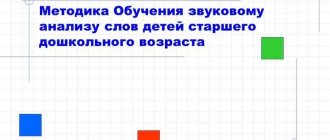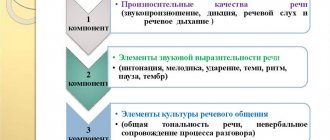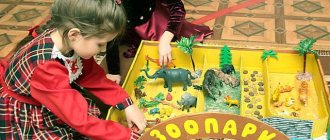Sound analysis of a word: what is it
First of all, it is worth giving a definition. So, sound analysis of a word is the determination of the order in which sounds are placed in a particular word and the characterization of their features.
Why do children need to learn to perform sound analysis of a word? To develop phonemic awareness, that is, the ability to clearly distinguish between sounds and not confuse words, for example: Tim - Dima. After all, if a child is not taught to clearly distinguish words by ear, he will not be able to write them down correctly. And this skill can be useful not only when studying the grammar of your native language, but also when studying the languages of other countries.
Children's helpline
Consultation for parents on preparing children to learn to read and write
"Sound analysis of the word."
Hello, dear parents ! I propose to talk about preparing children for learning to read and write , namely about conducting a sound analysis of words . Written speech is formed on the basis of oral speech. And the first steps to learning to read and write should not be familiarity with letters, but the acquisition of the sound system of the language .
Each of us will smile, remembering the “folk”
rule of the Russian language:
“as it is heard, so it is written
.
Indeed, if a child does not pronounce a sound correctly , it is unlikely that he will write it correctly in a notebook in the near future.
It is necessary to pay attention not only to the correct articulation of sound, but also to the child’s ability to isolate, that is, to hear sounds in a word .
This skill is developed through the systematic work of both teachers in kindergarten and parents at home in games such as: “Name the first sound in the word ”
,
“Choose
a word ” ,
“Catch
a sound ” ,
“Determine the position
of the sound in a word ” ,
“Find a place for the picture”,
etc.
Dear parents, remember:
1. Sound - we hear and pronounce.
2. We write and read letters.
3. Sounds are vowels and consonants.
Vowel sounds can be sung with a voice, while the air coming out of the mouth does not meet any obstacles. Consonant sounds are sounds that cannot be sung, because... the air coming out of the mouth when pronouncing them meets an obstacle.
There are six vowel sounds: A, U, O, I, E, Y
There are ten vowel letters: A, U, O, I, E, Y - corresponding to the sounds and four iotated, which indicate two sounds: Ya-ya, Yu-yu, E-ye, Yo-yo.
Vowel sounds are indicated in red on the diagram.
Consonant sounds are soft and hard.
Always hard consonants: Zh, Sh, Ts.
Always soft consonants: Y, Ch, Shch.
Hard sounds are indicated in the diagrams in blue, soft sounds in green.
Teaching children the sound analysis of words begins with determining the sequence of sounds in a word : this sequence must be identified by repeatedly pronouncing the word with intonation highlighting each sound . So, when analyzing the word “BEETLE”
the child must pronounce it three times:
“ZZHUK”
,
“ZHUUK”
,
“ZHUK”
.
In order for a child to analyze a phenomenon , it must be understandable and materially presented.
Let's draw a diagram of the sound composition of the word : in the word “house”
three
sounds - let's draw three cells. And we’ll give the child this card: a house is drawn on it, so that it’s clear what word we’ll be analyzing , and under the house there’s a diagram of this word : the child already knows that words consist of sounds .
We show him that the cells under the picture tell us how many sounds there are in the word . “How many cells?” - "Three". - “How many sounds are in a word ?” - “Also three.” - “Let's look for these sounds . Say the word home so that I hear the first sound .” Our child already knows how to do this - he learned it at the first stage of education . “D-house,” the baby diligently pronounces. - “What is the first sound ?” - “D.” - "Very good! Let’s cover the first cell with a chip, what sound ?” - “D.”
You can use any material as chips: cut squares out of white cardboard or take an old mosaic and select white or yellow elements from it. Don't take red, blue, green ones - you'll need them later.
So, in front of the child is a diagram of the sound composition of the word “house”
, in which the first cell is already closed. We can move on.
“Let’s now say the word “home”
so that we can hear the second
sound , the first d - we already know.” “do-oh-oh”
with him .
Here a diagram of the sound composition of a word : you need to pronounce the word and at the same time move your finger along the diagram and stop it for a long time on the second cell. We keep our finger on the second cell of the diagram, and you and your child spend a long time saying “do-o-oh”
.
“What is the second sound in this word ?” - "ABOUT!" - "Great! Let’s designate this sound with a chip !”
The child takes a chip exactly the same as the first one and places it on the second square. “You see,” you continue, “we already know two sounds in the word “house”
.
Let's find the last sound in this word . Say the word “house”
so that the last
sound “” is heard.
And again you run your finger along the almost completed word pattern and say : “house-mmm.” “What is the last sound in the word house-mmm ?” “Mmm,” the child answers and puts the last, third chip on the diagram.
This is the first time a sound analysis of a word .
It would be good to repeat it again. But how? Take off the chips and start over? This is not interesting for the baby! No, it’s better to play the game “Who is attentive.” “And now,” you say, “I will call the sound , and you will remove its designation from the diagram. Let's see how attentive you are. Please remove the sound designation “d ” (blue chip)
For this type of analysis , the child is offered words of three sounds : poppy, house, cheese, cat, whale, ball, beetle, onion, forest, cancer.
When working with a child, you need to remember all the time: we teach him the sound analysis of words , we teach him to listen attentively to the word , to hear the sounds and its components. Therefore, the child must name the sounds as they are heard in the word .
This type of work with sounds is especially important for children with speech impairments. If you see that your child cannot cope the sound analysis of a word games to develop phonemic awareness.
In the process of analyzing three sound words, remind your child about the presence of vowels and consonants in the language . First, ask him to find the vowel sound in the word and replace the neutral chip with a red one.
Then remember that consonant sounds are soft and hard: hard sounds are denoted by blue chips, and soft sounds by green chips. Thus, now when drawing up word , the child will use chips of three colors.
All characteristics of sounds are given ORAL (no need to write down)
.
If the child wants, arrange the model of the word in the form of an application, so that you can then show it to someone else (ask your grandparents to “guess”
what these
“mysterious squares”
).
The order of parsing words by sounds
When performing a sound analysis of any word, you must first place the stress and then divide it into syllables. Then find out how many letters are in the word and how many sounds. The next step is to analyze each sound step by step. After this, it is calculated how many vowels and how many consonants are in the analyzed word. At first, it is better for children to be given simple one-syllable or two-syllable words for analysis, for example their names: Vanya, Katya, Anya and others.
When the child has gradually figured out how to correctly carry out analysis using simple examples, it is worth complicating the analyzed word examples.
Sound analysis of a word: diagram
When working with very young children, special colored cards are used to better assimilate information.
With their help, children learn to create a sound analysis scheme.
The scarlet card is used to represent vowel sounds. Blue - hard consonants, green - soft. To indicate syllables, two-color cards in the same color scheme are used. With their help, you can teach your child to characterize sounds and whole syllables. You also need a card to indicate stress and a card to show the division of the word into syllables. All these designations, which help teach a child to make a sound analysis of a word (the diagram plays an important role in this), are approved by the official school curriculum in Russia.
Teaching sound analysis of words to children of senior preschool age. - presentation
Teaching sound analysis of words to children of senior preschool age
Contents: Didactic materialDidactic material. Methodical teaching techniquesMethodological teaching techniques. Introducing vowel sounds. Introducing consonant sounds. (hard and soft)Introduction to consonant sounds. Working with the sound circuit. Consolidating the skill of sound analysis of words. Consolidating the skill of sound analysis of words.
Contents: (cont.) Introduction to impact soundIntroduction to impact sound. Game exercises Game exercises. LiteratureLiterature. Check yourselfCheck yourself.
Sound analysis of a word means determining the order of sounds in a word, establishing the distinctive role of sound, and the main qualitative characteristics of sound.
What methodological techniques make the process of teaching sound analysis attractive to a preschool child?
Didactic material Pictures with sound diagrams Handouts Demonstrations
Chips - sounds Demonstration Handouts 6 cm. 10 cm Set for each child 2 cm 2 cm. 4 of each color (black -1)
Sound cards Demonstration Handout 40 cm. 15 cm. 2.5 cm 2.5 cm.
Subject pictures
Methodological teaching techniques The teacher pronounces words with intoned emphasis on the first sound. Children, following the teacher, pronounce the word in the same way, moving their pointers along their patterns and holding the pointers on the pronounced sound. Places a gray chip in the first cell. The teacher names the first sound, as it is heard in the word.
Determining the sequence of sounds in a word You need to identify the sequence of sounds by repeatedly pronouncing the word with sequential intonation of each sound. RRRAK RAAAK RA K
Representing a word in the form of a model A picture-scheme of its sound composition makes it possible to really imagine a word. A drawing-object is placed on it, under which there are a number of cells that are sequentially filled with chips (first gray, then colored). The number of cells corresponds to the number of sounds in the word.
Acquaintance with vowel sounds Sounds during the formation of which air passes freely (nothing “interferes” with it - neither lips, nor teeth, nor tongue) are called vowels. Children find such sounds in previously analyzed three-sound words.
Sound analysis of the word BOW When determining the vowel sound, lay out a red chip. Children learn that there are 6 vowel sounds in the Russian language [a] [o] [e] [i] [s] Children, with the help of a teacher, “check” all the sounds, pronouncing them, and observe whether anything in their mouth bothers them their pronunciation. [y]
Introducing consonant sounds (hard and soft) The hard consonant sound “big brother” is indicated by a blue chip. The soft consonant sound “little brother” is indicated by a green chip. Sounds during the formation of which air does not pass freely and encounters obstacles are called consonants
Sound analysis of the word MOON How many sounds are in the word MOON? 4 How did you know? Four cells under the picture. Pronounce the word so that the first sound is clearly heard. When we pronounce it, our tongue gets in the way. L is a hard consonant sound, denoted by a blue chip.
Familiarization with soft consonant sounds Sound analysis of the word FOX Pronounce the word so that the first sound is clearly heard. LLLISA Sound L - “big or little brother”? Small. The sound Ль is a soft consonant sound, we denote it with a green chip. Next, the word is analyzed by analogy.
Working with the sound chart Children read the word by pointing under the sound card, recording each sound. According to the instructions, sound chips are removed. Remove the sound Къ Remove the first sound, call it -НН Remove the hard consonant sound. Remove the first vowel sound, call it - And Remove the second sound And
Strengthening the skill of sound analysis of words
Sound analysis of the word YULA Extend the first sound in the complete word. Name the first sound in the word. What is he like? What kind of chip do we denote? Name the second sound in the word. What is he like? What kind of chip do we denote? Name the third sound in the word. What is he like? What kind of chip do we denote? Name the fourth sound in the word. What is he like? What kind of chip do we denote? Read the entry.
Familiarization with the stressed sound Perform a sound analysis of the word GUSI Name the vowel sounds of How many syllables are in the word? Two Which? GUSI Name the stressed syllable GU Say the word with the accent GUUUSI and
In a stressed syllable, the vowel sound is pronounced protractedly. The teacher reads the word with emphasis synchronously moving the pointer under the diagram. Children repeat The teacher says GUSIIIIGUSIIII Which sound is highlighted? And How to say it correctly? GUUUSI The vowel sound in a stressed syllable is called stressed, which is pronounced more drawn out in the word. A stressed vowel sound is indicated by a black chip.
Game exercises Why did you decide this? 1 2 Match the diagrams to the pictures
Perform a sound analysis of the word BEETLE Change the diagram so that you get the word BEETLES Change the scheme
Perform a sound analysis of the word MOUSE Change the diagram so that you get the word BEAR
Match the words to the diagrams Vegetables, fruits
Literature: Teaching preschool children to read and write / L.E. Zhurova, N.S. Varentsova, N.V. Durova, L.N. Nevskaya / Ed. N.V. Durova.-M., 2001.
Test yourself Which word does the diagram go to?
WRONG!
RIGHT!
Vowel sounds and their brief characteristics. Diphthongs
Before you start analyzing a word, it is important to know what features all phonetic sounds (vowels/consonants) have. When teaching children in the early stages, it is necessary to provide information only about the simplest properties; the child will learn everything else in high school.
Vowel sounds (there are six of them: [o], [a], [e], [s], [u], [i]) can be stressed/unstressed. Also in Russian there are letters that in a certain position can produce a pair of sounds - ё [yo], yu [yu], ya [ya], e [ye].
If they follow consonants, they sound like one sound and add softness to the preceding sound. In other positions (the beginning of a word, after vowels and “ъ” and “ь”) they sound like 2 sounds.
MAGAZINE Preschooler.RF
SOUND-LETTER ANALYSIS OF WORDSEducator: Diana Vitalievna Ilyinskaya MADOU “DS No. 48” SEVERSK TOMSK REGION
Goals and objectives: development of sound-letter analysis and synthesis of words; learn to correlate sounds with letters and symbols.
Teaching children to read and write in kindergarten is carried out using the analytical-synthetic method. This means that children are introduced to the sounds of their native language first and then to the letters. A modern school, according to the Federal State Educational Standard, requires from children entering the first grade not so much any amount of knowledge and skills, but the ability to act in the mental plane, which is formed in the process of mastering a system of knowledge in a particular area of reality.
Therefore, already at preschool age, it is necessary to help children master a certain system of knowledge, which will become the basis for future study of the subject. Sound analysis is the determination, firstly, of the order of sounds in a word, secondly, the selection of individual sounds, and thirdly, the distinction of sounds according to their qualitative characteristics. The Russian language is characterized by the opposition of vowels and consonants, hard and soft consonants.
The ability to hear and isolate all sounds in order prevents skipping letters in the future when writing.
After classes in the middle group, five-year-old children are prepared to master sound analysis: they can identify sounds intonationally and determine the first sound in words.
But in order for a child to analyze a word, its sound composition must be materialized. The spoken word escapes, and it is very difficult for a child to identify certain parts or elements in it. It needs to be shown to preschoolers in terms of subject matter, presenting the sound structure in the form of a model.
For this purpose, a picture-scheme of the sound composition of words is used. It depicts an object, the name of which the child parses and places a row of chips under the picture according to the number of sounds in the word.
The drawing helps to always see the object whose name is being analyzed. The diagram makes it possible to determine the number of sounds in a word and check the correctness of its filling with chips.
The main type of exercise that develops students' phonetic abilities is phonetic analysis.
Familiarization with the curriculum shows that phonetic analysis means sound-letter analysis. However, the methodology distinguishes between actual phonetic (or sound, and phonetic-graphic (or sound-letter)) analysis. The purpose of the first is to characterize the sound structure of a word without resorting to letters, the second includes actual phonetic analysis only as its initial stage, since its main task is to clarify the relationship between the sound structure of a word and its letter designation.
Children actually perform sound analysis during the preparatory period of learning to read and write. With the transition to the study of letters, sound analysis is unfairly almost completely eliminated from use.
However, noting the importance of phonetic analysis itself, one cannot help but admit that it is natural that the main type of exercise from the moment children become familiar with letters is sound-letter analysis in its two varieties.
If we want to ensure that the child actually operates with sounds, that is, so that his phonetic hearing develops, it is advisable to conduct sound analysis in this sequence.
- Say and listen to the word
- Find the stressed syllable
- Say the word syllable by syllable
- Draw out (highlight with your voice) the first sound in a complete word, name it and describe it
- Indicate the selected sound with a symbol
- Do this until the end of the word
- Say all the named sounds in a row. Listen to whether the word came out.
Let's comment on each point of this plan.
- Say and listen to the word. This stage in working on a word is extremely important for the development of phonemic hearing of the child who is presented with the object of the upcoming analysis. The sounding word exists for an instant. Then he disappears. It is invisible, intangible. At the same time, it is necessary to ensure that students pronounce words in accordance with the norms of Russian literary pronunciation. Thus, the first stage of working with a word during sound analysis also becomes a means of developing a culture of oral speech in students.
- Find the stressed syllable. Before isolating individual sounds in a word, it is necessary to find a stressed syllable, since the lexical meaning of the word sometimes depends on this. For example: [zamo'k], [zamo'k]. At the same time, children should know that a stressed syllable is only in a complete word.
- Say the word syllable by syllable. The student must say the word twice. The first time he pronounces it entirely with a questioning or vocative intonation, which helps to easily find the stressed syllable. The second time the word is pronounced syllable by syllable.
- Draw out (highlight with your voice) the first sound in a complete word, name it and describe it. This is actually the beginning of the sound analysis of the word. Children need to be taught to stretch out the sound, artificially lengthen it, or designate it in some other way. For example, if the sound is plosive ([k], [d]…), it can be repeated [kkot] or pronounced with effort while exhaling. This will help you hear the sound better. By isolating a sound in a complete word, the child controls whether the word is distorted, since there is an inextricable connection between the lexical meaning and the sound of the word. Distortion of one of the elements of this integral connection destroys it.
- Indicate the selected sound with a symbol. At the stage of sound analysis of a word, its recording with conventional symbols of each sound should not be associated with letter symbols. Over time, children, led by the teacher, will correlate these conventional icons with transcription icons and write the word like this: [p'is'mo]. At first, words that do not have spellings are used for sound analysis.
Sound-letter analysis is one of the most important types of work, which contributes to the further formation of spelling vigilance and the development of phonemic hearing; developing the ability to isolate sounds in a word, correctly name and characterize them; the ability to correlate a word with its sound pattern and much more.
I carry out the work of sound-letter analysis of a word as follows:
I. I distribute cards:
II. I find out:
- What is shown in the picture?
- We divide the word into syllables (draw a line with a colored pencil), put an emphasis (with a colored pencil).
- Count the cells with letters?
- Count the empty cells?
- Which cells are there more (or less)?
- Let's find out why there are more empty cells (less, the same)? The letter Yu gives two sounds [th] and [y], and in the word trees - ь - does not indicate the sound [], but the letter i - gives two sounds [th] and [a] rush - does not make a sound).
- We pronounce the word, listen to ourselves: we find out that the letter Y makes two sounds.
- We print sounds into empty cells.
- We find out whether all sounds are pronounced in the same way as they are written (printed), that is, we check the spelling of the word with the sound scheme. (For example, in the word lion, the letter v will give the sound [f]; in the word trees - b - does not indicate the sound [], but the letter i - will give two sounds [th] and [a], fruit - the letter d - will give the sound [ T]).
- We characterize the sounds (vowel - stressed, unstressed, consonant - hard, soft, voiced, voiceless) by coloring the squares with colored pencils (green, blue, red), or laying out colored squares (green, red, blue) in accordance with the characteristics of the sound.
In their work they relied on the research of: A. M. Borodich, G. S. Shvaiko, A. I. Maksakova, A. N. Gvozdeva, E. V. Kolesnikova, G. G. Golubeva, G. A. Tumakova, V. V. Gerbova, T. A. Tkachenko, A. K. Bondarenko, E. A Strebeleva, T. B. Filicheva, N. V. Novotortseva, etc., using the tables:
List of used literature.
- Aleksandrova T.V. “Living sounds or phonetics for preschoolers” // “Child in kindergarten” . -2005. — No. 5, 6, 7, 8.
- Vasilyeva V.V. “Program for the education and training of children in kindergarten . - M.: “Enlightenment” , 2008.
- Gerbova V.V. “Development of speech of older preschoolers in kindergarten” - M.: “Prosvesh 2008.”
- Ilkonin D. B. “How to teach children to read” - M.: 1976
- Kolesnikova E. V. Program for preparing preschool children for literacy training “From Sound to Word” (author’s program) ed. 2 – e. M.: Publishing house. "Juventa" , 2001 - With. 18 6.
Kolesnikova E. V. “Development of sound-letter analysis in children 5-6 years old . M.: ed. "Juventa" , 2003
7. Kolesnikova E. V. “Development of phonemic hearing in preschool children . M.: ed. "Juventa" 2005
8. Kulikovskaya T. A. “The best speech therapy games and exercises for speech development” LLC publishing house ASTREL M.: 2009.
9. Maksakova A. I. “Is your child speaking correctly” - M.: Mosaika - Synthesis, 2005
10. Maksakova A.I. “Development of correct speech of a child in the family” - M.: Mosaic - Synthesis, 2005.
| Next > |
Brief characteristics of consonants
There are thirty-six consonant sounds in our language, but they are represented graphically by only twenty-one characters. Consonants are hard and soft, as well as voiced and voiceless. They also may/may not form pairs.
The table below lists voiced and unvoiced sounds that can form pairs, and those that do not have this ability.
It is worth remembering: the consonant sounds [th`], [ch`], [sh`] are soft in any position, and the consonants [zh], [ts], [sh] are always hard. The sounds [ts], [x], [ch`], [sch`] are absolutely always unvoiced, [m], [n], [l], [р], [й`] are (sonorous) or voiced .
Soft and hard signs do not produce sounds. The soft sign makes the previous consonant soft, and the hard sign plays the role of a sound separator (for example, in Ukrainian the apostrophe plays a similar role).




